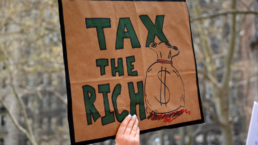To become a party based among workers again, Democrats must remember that partisan commitment often grows from local roots.
By Michael Kazin, Dissent
Everybody knows most white working people no longer vote for Democrats, but there’s no agreement why. Leftists blame neoliberals for enacting policies that deregulated business instead of redistributing wealth. Conservatives and some liberals argue that the fault lies in cultural ideas and principles that progressives have compelled Democrats to embrace—from transgender rights and restrictions on gun ownership to critical race theory and a dismissal of religious faith. Others, echoing the Marxist notion of “false consciousness,” accuse ordinary white people of fearing Black Americans and undocumented immigrants instead of making common cause with fellow workers of different racial or national backgrounds.
Whatever insights these explanations offer should be qualified with a healthy dose of historical perspective. Back in the middle of the last century, Democrats routinely won the votes of white working people who were, if anything, more culturally conservative and accepting of racist myths and structures than they are now. And despite having tiny majorities in Congress or none at all, Democrats during the tenure of Joe Biden have made a serious effort to enact policies on trade, infrastructure, child care, student loan forgiveness, green jobs, and labor law that represent a decisive turn away from the corporate-friendly stance Bill Clinton adopted three decades ago. Still, the president from Arkansas surged to reelection in 1996 with huge majorities among white voters with a high school education or less. They backed him even though, with the help of Republicans, he had pushed a free trade agreement through Congress that shrank the number of good union jobs available in U.S. factories.

A primary reason why the “party of the people” once secured the allegiance of working-class Americans was that a sizeable number belonged to labor unions in the private sector. Through their leaders and official periodicals, those unions routinely taught them that the Democrats, whatever their flaws, were the only party that looked out for their interests instead of catering to those of wealthy Americans. Who had enacted Social Security and Medicare, protected the right to organize, and called for lowering their taxes and raising them on corporations and the rich? Some of the biggest industrial unions—the United Auto Workers (UAW), United Steelworkers (USW), and United Mine Workers (UMW)—were also interracial oases in a segregated society. The gradual but steady decline of unions in the private sector, from 35 percent in the mid-1950s to a mere 6 percent today, cleared the way for conservative churches, right-wing networks and social media, and the National Rifle Association to conduct their own kind of political education—and quite effectively too.
The modest revival of unions, ardently supported by Biden and his appointees to the National Labor Relations Board, stirs hope that Democrats might win back a sizeable percentage of those white voters again. If the party also retained its growing edge among college-educated voters of all races, Democrats would be able to forge a new majority coalition—something that has not existed in the United States since the New Deal order crumbled at the end of the 1960s.
However, as Lainey Newman and Theda Skocpol argue in their recent book, Rust Belt Union Blues: Why Working-Class Voters Are Turning Away from the Democratic Party, it is not the mere fact of belonging to a union but the character of the organization that can make an electoral difference. A local where members build a community of shared interests outside the workplace can sway white workers to stick with Democrats. But one that treats them mainly as anonymous dues-payers can leave them either indifferent or hostile to the party the union’s leaders still endorse. Genuine solidarity gives members a reason to trust the choice those leaders make; indifference breeds suspicion and a search for other kinds of networks in which to find friendship and meaning. Newman and Skocpol study a richly detailed microcosm of the problem: steelworkers and electrical workers in western Pennsylvania—a bastion of liberal Democrats during the New Deal Era that, outside of Pittsburgh, has become a Donald Trump stronghold.
Recent Posts
Billionaire’s Mouthpiece Searches For Reasons To Avoid Taxing Billionaires
January 9, 2026
Take Action Now California is considering a referendum on whether to impose a one-time wealth tax on the state’s billionaires.By Jim Naureckas,…
All Democratic Presidential Candidates In 2028 Should Commit To Dismantling ICE
January 8, 2026
Take Action Now Since its inception, ICE has been designed to conflate issues of immigration with terrorist threats against the U.S.By Sam…
Trump Cuts Billions In Federal Childcare Funds For Democratic-Led States After Minnesota Fraud Scandal
January 8, 2026
Take Action Now Administration cites welfare fraud allegations as advocates and state leaders warn of political retaliation and sweeping harm to…
After The ICE Killing In Minneapolis, Will Truth Prevail?
January 8, 2026
Take Action Now Can Trump and Kristi Noem maintain their blatant lies in the face of multiple videos that show the victim was trying to drive away…




